Analysis of Mathematics Problem Solving Ability in View of Extrovert-Introvert Personality Types
DOI:
https://doi.org/10.30736/voj.v6i1.919Keywords:
Problem Solving, Mathematics, Extrovert-IntrovertAbstract
This study was conducted to analyze mathematical problem solving in terms of opportunities in terms of extrovert-introvert personality types in class X of SMKN 1 Patumbak. Researchers took samples, namely class X Rpl students of SMK Negeri 1 Patumbak with a total of 35 students. Sampling is taken by purposive sampling technique, also known as consideration sampling, which is a sampling technique from the population on certain considerations. Instruments and data collection techniques were carried out, namely by distributing questionnaires, conducting interviews, and providing test instruments. From the tests conducted, it is known that students who have extroverted personalities are more enthusiastic in working on questions than students with introverted personalities. From these results it is known that students who have introverted personalities can write down answers, but are less able to explain the answers. Meanwhile, students with extroverted personalities tend to be more confident, both in writing answers and explaining answers.
Downloads
References
Ahda, H. (2018). The Influence of Polya Problem Solving Strategies on Students' Mathematics Learning Outcomes. Journal of Mathematics and Natural Sciences Educational Research , 197 (1), 197–201.
Elmarfia, B., & Yohanes, RS (2020). Analysis of Students' Thinking Process in Solving Mathematical Problems Using Higher Level Thinking Abilities in View of Extrovert and Introvert Personality Types. Scientific Journal of Mathematics Education (JIEM) Vol. 6 / No. 2 / October 2020 ISSN: 9772442878 , 6 (2), 95–112.
Gumilang, G.S. (2016). Qualitative Research Methods in the Field of Guidance and Counseling. Journal of Counseling Focus , 2 (2), 144–159. http://ejournal.stkipmpringsewu-lpg.ac.id/index.php/focus/a
Habibatul Izzah, K., & Azizah, M. (2019). Analysis of Students' Reasoning Abilities in Solving Mathematical Problems for Class IV Students. Indonesian Journal Of Educational Research and Review , 2 (2), 210–218. https://doi.org/10.23887/ijerr.v2i2.17629
Lia, S. (2022). Description of mathematical problem solving abilities in terms of extrovert and introvert personality types in class VII students at SMP Negeri Satap 15 Bulu Kumba. Thesis , 8.5.2017 , 2003–2005.
Listia, Y., Darmawani, E., & Darma Putri, R. (2022). Building personal communication through group discussion techniques for students who tend to be introverted. Science and Education Journal (SICEDU) , 1 (2), 72–80. https://doi.org/10.31004/sicedu.v1i2.18
Majiid, AM (2020). Increasing Students' Problem Solving Abilities. Journal of Elementary Education , 9 (1), 35–46.
Muslim, S. (2015). The Effect of Using the Student Facilitator and Explaining Method in Cooperative Learning on the Mathematical Problem Solving Ability and Mathematical Critical Thinking Ability of Vocational School Students in Tasikmalaya City. Journal of Research in Mathematics Education and Teaching , 1 (1), 65–72.
Mustakim, A. et al. (2020). The Effect of Using Physics Learning Modules Using a Research-Based Scientific Approach to Improve the Scientific Literacy of Class VIII Students at Takhassus Al-Qur'an 2 Dero Duwur Middle School, in Wonosobo, 2018/2019 Academic Year. Proceedings of the National Seminar on Physics Education FITK UNSIQ , 2 (1), 217–226.
Nirmayani, LH (2021). Approach to Citizenship Education as Character Education in Elementary Schools. Education: Journal of Elementary Education , 2 (2), 127–136.
Rozalina, S., & Nurdalilah, N. (2022). Analysis of problem solving abilities by applying blended learning assisted by Edmodo. Journal of Didactic Mathematics , 3 (3), 143–150. https://doi.org/10.34007/jdm.v3i3.1577
Saputri, DA, & Febriani, S. (2017). The Influence of the Problem Based Learning (Pbl) Model on Students' Problem Solving Ability in Biology Subjects, Environmental Pollution Material for Class X Mia Sma N 6 Bandar Lampung. Biosphere: Tadris Journal of Biology , 8 (1), 40–52. https://doi.org/10.24042/biosf.v8i1.1262
Sulastri, M., Hayati, L., Hikmah, N., & Azmi, S. (2021). Analysis of Mathematical Problem Solving Ability in terms of Personality Types of Madrasah Tsanawiyah Students. Griya Journal of Mathematics Education and Application , 1 (4), 648–659. https://doi.org/10.29303/griya.v1i4.123
Wahyuni, G., Mujib, A., & Zahari, CL (2022). Analysis of Students' Visual Thinking Ability in View from the Adversity Quotient. JUPE : Journal of Mandala Education , 7 (2), 289–295. https://doi.org/10.58258/jupe.v7i2.3335
Zuniana, ER, & Rahaju, EB (2019). Algebra Problem Solving for Middle School Students Seen from Personality Type. MATHEdunesa : Journal of Educational Mathematics , 8 (2), 342–349.
Downloads
Published
How to Cite
Issue
Section
License
Copyright (c) 2024 Vebiola Ardiani, Haryati Ahda Nasution

This work is licensed under a Creative Commons Attribution-NonCommercial-ShareAlike 4.0 International License.
Copyright:
Authors who publish their manuscripts in this Journal agree to the following conditions:
- Copyright of any article on Vygotsky: Jurnal Pendidikan Matematika dan Matematika is held solely by the author under the Creative Commons Attribution 4.0 International license (CC BY NC SA).
- Authors can submit papers separately, arrange non-exclusive distribution of manuscripts that have been published in this journal into other versions (e.g. sending to the author's institutional repository, publication in a book, etc.) by acknowledging that the manuscript has been published for the first time in Vygotsky: Jurnal Pendidikan Matematika dan Matematika.
License:
Vygotsky: Jurnal Pendidikan Matematika dan Matematika is published under the terms of the Creative Commons Attribution 4.0 International License (CC BY NC SA). This license permits anyone to copy and redistribute this material in any form or format, compile, modify and develop this material for any purpose as long as it is not for commercial purposes. Additionally, anyone must provide credit and distribute contributions under the license of the creator of the original work.











